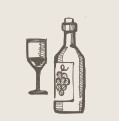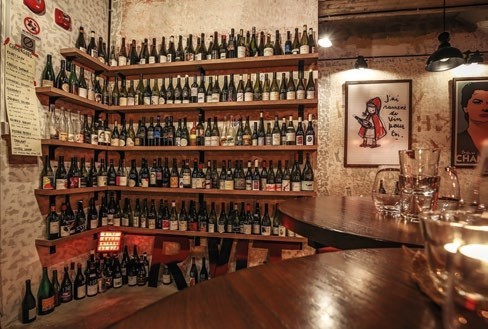Wine in the alcohol world is the sartorial equivalent of the LBD (little black dress) – a timeless staple for all occasions – it is trend-proof and never lets you down.





Pandora’s Garden 28 Ann Siang
Road Rose wine, a style that’s in-between white and red wine, has never been more in demand. The “pink drink” was declared the younger generation’s go-to beverage in 2017, but it’s not just a cheap or easy option. Sommeliers and wine experts alike are flocking to modern rose thanks to its versatility with food as well as the serious techniques used to make the wine. Pandora’s Garden has chosen to feature more than 30 labels of rose in a gardenlandscaped outdoor space protected from the elements by a retractable roof.
Approach the roses as you would red or white wine; learn what grapes and growing regions they are made from, and be rewarded with a wide range of blush. Anna Codorniu Rose Cava ($15 a glass, $60 a bottle) or an aptly named Little Black Dress Rose ($14 a glass, $58 a bottle) will start your evening off on a vivid note, with bright raspberry notes from the Spanish cava, and bold strawberry and grapefruit notes from the Californian label. Grenache, Rolle, Cinsault, Syrah and Mourvedre are the grapes used in Brad Pitt and Angelina Jolie’s awardwinning Chateau Miraval Rose,as well as in the world’s most lauded rose, Chateau d’Esclans’ Whispering Angel ($120-$535 a bottle).


Botanico, 50 Cluny Park Road

How to speak “wine”.
Alcohol by volume. Wine is typically at 11.5-15 per cent.
White wine made only from white wine grapes, especially in Champagne.
A winemaker who travels between the northern and southern hemispheres to make wine twice in a year.
Winemaking philosophy that believes in no or minimal use of mechanical, chemical and filtration techniques.
White wine made with some “skin contact” (grape skins are left to ferment with the juice to alter the character of the wine), resulting in more tannin and deeper flavours. (Note: It’s not the colour of the grapes that gives wine its respective red and white qualities.)
Petillant naturel wines in which carbonation occurs naturally in the bottle from secondary fermentation. It’s an older style of sparkling which is less fizzy than champagne.

PORT – NOW TRENDIER THAN EVER
Ma Cuisine, 38 Craig Road
One of the largest (with 600 labels) and most exciting port cellars in Asia is here to dispel the notion that the sweet Portuguese wine is stuffy and traditional. (Port is made from grapes grown in the Douro region, and it is fortified by adding a grape spirit to stop the fermentation and boost the alcohol content.)
Mathieu Escoffier and his business partner Anthony Charmetant are the young faces behind the hip gastro wine bar Ma Cuisine, which scooped its first Michelin star just seven months after opening in January. Here, an eclectic soundtrack of funk, nu-disco and house music keeps the atmosphere lively, while the comfort French fare and wine list do the heavy lifting. You can find young Rhone wines for under $100, or vintage port in your birth year that is refined and complex, not cloying or overly sweet.

RVLT, 38 Carpenter Street
Guzzle your vino from a stemless glass as you rock out to the decidedly highdecibel playlist. Welcome to two-year-old wine bar RVLT, which always keeps things rebellious – such is the nature of its offerings, comprising a revolving 100-plus selection of natural wines which should be drunk young. With a distribution arm bringing in must-know names like J. Zillinger from Austria and Domaine Parent from Burgundy, the list is more varied than ever.

Name-drop these wine-growing areas for maximum vinous cred.
While most folks associate Austria with white wines like Gruner Veltliner, its easternmost area is particularly adept at red varieties. Indigenous grape varieties like Blaufrankisch and Zweigelt have a range of expressions, from fresh, easy-drinking rose to structured heavyweights with oak ageing. As versatile as Pinot Noir, these grapes are to be taken seriously. Get them from: www. schmidtmarketing.com
Just north of capital Montevideo is Canelones, which boasts 60 per cent of the country’s winemaking output. Its queen of grapes is Tannat, originally from south-west France but transplanted by Basque immigrants and adapting perfectly to the damp weather and clay-rich soils. Tannat wines from Uruguay are typically softer, with less tannin. Get them from: www.certaincellars.sg
In the hillsides of Istria, you’ll find echoes of neighbouring Italy, especially in the local grape variety, Refosk (Terrano in Italy, and Teran in Slovenia). Grown on highly prized red clay soil (terra rossa), the grape has high acidity and grassy, spiced and peppery notes. Malvazija Istarska is the main white, with dry notes of quince, fennel and apricot. Contact: moritz@ampelia.com.sg
LVMH’s multimilliondollar venture into the wine trade here has turned attention to south-west China. Grapes for church wine were introduced in the 19th century by French missionaries, while more recent plantings of international varieties in the early 2000s have seen vines thrive at an altitude of 2,000m. Ao Yun 2014 retails at the US$300 (S$410) mark. Get it from: www.vinum.com.sg

CHAMPAGNE TRUMPS GIN
Atlas, Parkview Square, 600 North Bridge Road
The bar may have almost 1,000 gins and eighth spot on the World’s 50 Best Bars list, but it is equally famous as a champagne wine bar, with more than 300 labels of French bubbly not to be sniffed at. Head sommelier Lucas Liu, 27, is working on a buffed-up list to help newbies zero in on the style of bubbly they enjoy, such as the Heidsieck & Co Monopole Gout Americain ($170 a bottle), a revival of the original 1907 label, with a soft, slight sweetness unusual in today’s champagne profi les.
A major draw is the rare and vintage champagnes that are sourced from the Hong Kong cellars of the Hwang family (Atlas’ owners), who have exclusive back vintages of Champagne Salon and even “shipwreck wines” rescued from the bottom of the ocean. Yes, the original Heidsieck & Co bottle mentioned above – which was salvaged – will set you back a cool $190,700. Toast gently.
HIGHESTRATED WINES, MOST MODEST PRICES
Park90, Regent Hotel, 1 Cuscaden Road
The wine list here runs over 20 pages, and most of the 800 wines are rated above 90 Robert Parker points (the unspoken industry standard for excellence). The best part is, prices are friendly, with an expanding selection by the glass that starts with a house pour of Champagne Marguet Shaman 13 Grand Cru NV, a steal at $20 a glass and $69 a bottle. That’s a boutique Grand Cru Champagne for the price of a massproduced bottle!
You can also go big with a glass of Domaine de la Romanee-Conti 2009 at $5,500 for the pour. The ambitious company is expanding overseas, and has just snagged 28-year-old award-winning sommelier, Yeo Xi Yang, known for his rapport with customers. Yeo predicts that trending rose will become even more popular in the coming year.

Master of the House
Singapore unexpectedly levelled up when we welcomed our first Master Sommelier in 2018 (the world has fewer than 300 master somms; it’s one of the hardest certifications to earn.) We got Ce La Vi’s Mathias Camilleri – he’s half French, half Singaporean – to pore over our wine list.
Are wine tastes different in Europe and Singapore?
In a cosmopolitan country like Singapore, I see more common points than differences. Probably the most significant trait is the taste for quality products like premium wines from the Old World and New World, and the curiosity to discover new products. One of the main differences is the timing of when new trends reach this city. For example, the current hot trend in Singapore is natural wines, which started to be popular in early 2010 in Europe. I also remain fascinated by the high consumption of heavy red wines (above 14 per cent) or spirits like brandies and whiskies in such a warm country.
Do you have some insider tips on how to read a wine menu?
At times, the cover of a book says more than we think. The wine list is the first tool of a sommelier; it represents her/his wine story through the vineyards and the winemakers she or he has visited and met, the wines shared with friends, family or colleagues. A sommelier will always try to reflect her/ his passion and care through the wine list.
Your new menu includes less obvious reds/whites – like Condrieu or Madiran. Why should we try these instead of chardonnay or pinot noir?
Ce La Vi’s wine list is organised by grape varieties. The idea behind a page like “Less Obvious” is to regroup the wines into one page where some of the grapes that are less famous can be discovered by our guests if they don’t know them, or be brought to mind if they know them.
In your one-page Sommelier List, you’ve included the likes of Super Tuscan Tignanello 2004 ($1,208 a magnum) and cult Australian Henschke Hill of Grace 2009 ($1,430). What’s the idea behind this?
Guests have asked me before if I have a special selection of premium wines. I also believe that most people don’t want to waste time looking for wines for their night. The Sommelier List was created so that passionate wine lovers could find all our iconic wines in one section.
Any wine trends that you’ve spotted for 2019?
Wine trends are difficult to predict. Wine is a unique beverage that can make a meal or a moment sublime. People just need to drink more affordable wines to be more knowledgeable.
PHOTO OF RVLT JONATHAN YEAP PHOTOS 123RF























